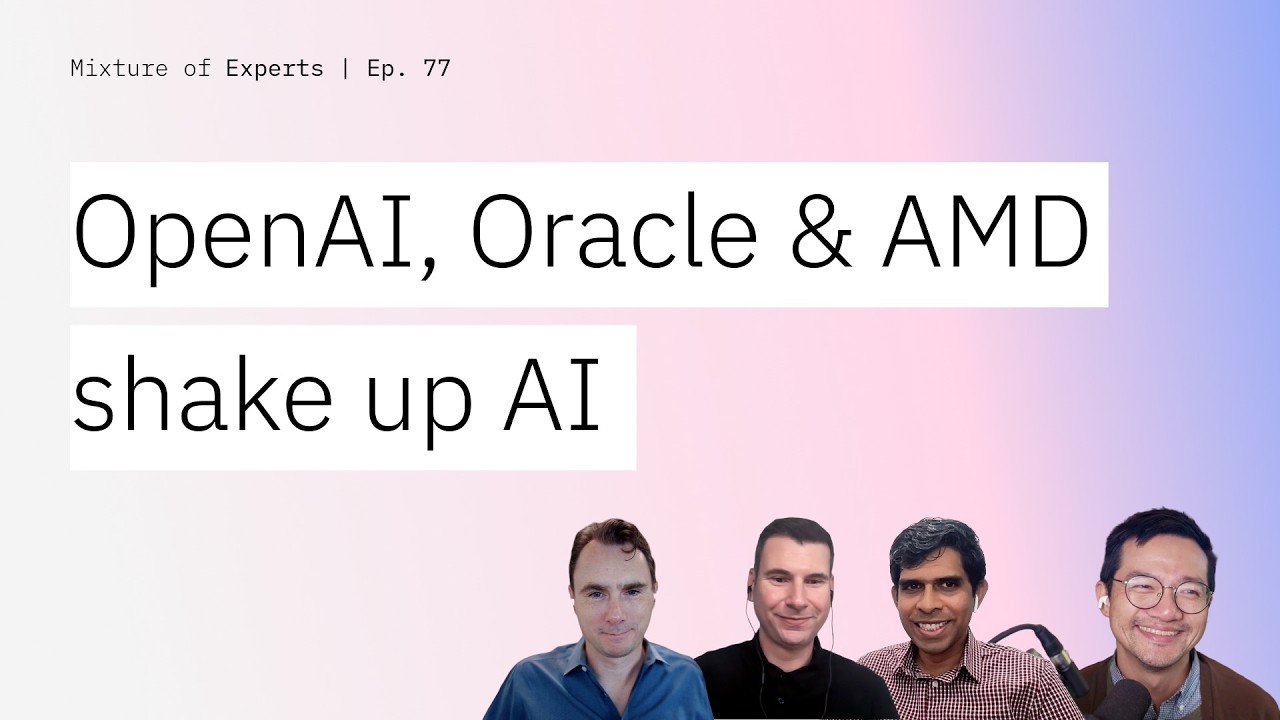The panel discussion highlights OpenAI’s strategic partnerships with AMD and Oracle, signaling a shift in AI infrastructure away from Nvidia’s dominance, while addressing technological, economic, and competitive dynamics in the AI hardware market. It also explores the evolving AI landscape through evaluations of Chinese models, skepticism about new foundational AI startups, and the transformative role of AI in venture capital, emphasizing AI’s augmentation of human roles rather than replacement.
The video features a panel discussion on the evolving landscape of artificial intelligence, focusing on recent developments involving OpenAI, Oracle, and AMD. A major highlight is Oracle’s announcement to deploy 50,000 AMD chips by the second half of 2026, following OpenAI’s deals with AMD and Oracle, including a potential $300 billion five-year agreement. The panelists discuss how this signals a shift in the AI infrastructure market, traditionally dominated by Nvidia, with OpenAI diversifying its hardware partnerships by investing in AMD and collaborating with Oracle. This diversification reflects broader market dynamics where investments circulate among major players, raising questions about the sustainability and real economic value behind these financial flows.
The conversation then shifts to the competitive dynamics between Nvidia and AMD, particularly focusing on the technological moat Nvidia holds through its CUDA platform. While Nvidia’s CUDA remains a significant advantage due to its maturity and proprietary nature, AMD is making strides with its open-source ROCm platform and hardware improvements. The panelists note that compatibility layers and programming abstractions like OpenAI’s Triton are helping to bridge the gap, potentially weakening Nvidia’s dominance. However, energy consumption and infrastructure limitations are emerging as critical bottlenecks, with the massive power requirements of AI data centers prompting discussions about vertical integration and the future of AI hardware deployment.
Next, the panel examines a recent report from the U.S. Department of Commerce’s Center for AI Standards and Innovation evaluating the Chinese AI model DeepSeek. The report finds that DeepSeek lags behind U.S. models in performance, cost, security, and adoption, tempering earlier concerns about its competitive threat. The experts emphasize that benchmarks alone do not fully capture a model’s utility, especially in enterprise contexts where security and trustworthiness are paramount. They also highlight the limitations of public benchmarks, noting that proprietary, black-box evaluations are often more indicative of real-world performance and that open-source models like DeepSeek contribute to a broader ecosystem by enabling transparency and stress testing.
The discussion then turns to the startup Reflection AI, which recently raised $2 billion at an $8 billion valuation with ambitions to be a leading open-source frontier AI company in the U.S. The panelists express skepticism about the viability of new foundational model companies given the crowded market and the dominance of established players like Meta and OpenAI. They suggest that while open-source models remain important, the industry is shifting focus from foundational models to verticalized applications and specialized use cases. The conversation also touches on the potential for new business models that provide foundational AI technology as a service, enabling companies to build proprietary models more cost-effectively.
Finally, the panel explores a novel approach by a small venture capital fund, DVC, which claims to have replaced all its analysts with AI agents to assist in deal sourcing and due diligence. While the fund is small and the move is partly marketing, the experts see this as emblematic of a broader trend where AI transforms rather than replaces human roles. They discuss how AI can augment human capabilities, creating new roles such as AI translators, ethics engineers, and agent orchestrators. The conversation concludes with reflections on the nature of early-stage venture investing, emphasizing that relationships and market intelligence remain critical, and that AI tools are likely to enhance rather than eliminate the human element in investment decision-making.
